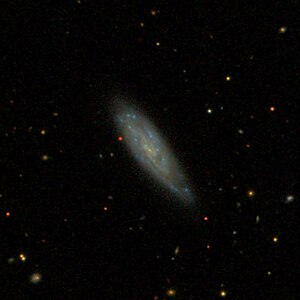NGC 4238
| Galaxy NGC 4238 |
|
|---|---|

|
|
| SDSS recording | |
| AladinLite | |
| Constellation | Dragon |
|
Position equinox : J2000.0 , epoch : J2000.0 |
|
| Right ascension | 12 h 16 m 56.0 s |
| declination | + 63 ° 24 ′ 38 ″ |
| Appearance | |
| Morphological type | Sd / BrClG / HII |
| Brightness (visual) | 13.5 likes |
| Brightness (B-band) | 14.2 mag |
| Angular expansion | 1.80 'x 0.5' |
| Position angle | 36 ° |
| Surface brightness | 13.2 mag / arcmin² |
| Physical data | |
| Redshift | 0.009213 ± 0.000037 |
| Radial velocity | 2762 ± 11 km / s |
|
Stroke distance v rad / H 0 |
(128 ± 9) · 10 6 ly (39.3 ± 2.8) Mpc |
| history | |
| discovery | William Herschel |
| Discovery date | March 20, 1790 |
| Catalog names | |
| NGC 4238 • UGC 7308 • PGC 39366 • CGCG 315-031 • MCG + 11-15-041 • IRAS 12145 + 6341 • 2MASX J12165577 + 6324358 • GC 2826 • H III 851 • h 1164 • | |
NGC 4238 is a spiral galaxy with extensive star formation regions of the Hubble type Scd in the constellation Dragon in the northern sky . It is estimated to be 128 million light years from the Milky Way and about 65,000 light years across.
The galaxy NGC 4205 is located in the same area of the sky .
The object was discovered by Wilhelm Herschel on March 20, 1790 .
